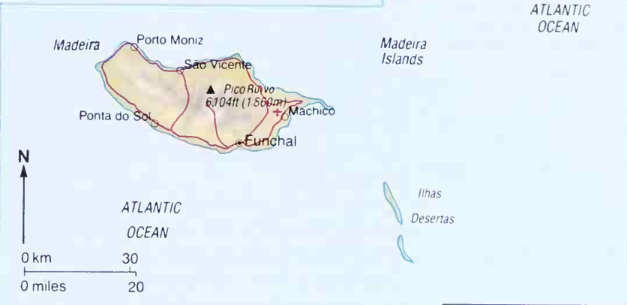The Azores and Madeiras. The Madeira Islands
In addition to its mainland territory, the nation of Portugal also includes two island groups in the Atlantic Ocean, the Azores and the Madeiras. The Azores lie about 800 miles (1,300 kilometers) off the west coast of Portugal. The Madeiras are situated about 350 miles (560 kilometers) off the northwest coast of Morocco. Both are autonomous (self-governing) regions of Portugal.

The Azores, map, have been part of Portugal since they v\/ere claimed in 1431 by Portuguese explorers. The seafarers named the island "Azores' after the hawks that constantly circle the islands, which they thought were vultures.
The Azores. The Azores are actually the peaks of a huge undersea volcanic mountain range that extends down the Mid-Atlantic Ridge from Iceland almost to Antarctica. The islands consist of three groups spread across about 390 miles (630 kilometers) of ocean. About 249,500 people live in the Azores.
Navigator Gonzalo Cabral claimed the Azores for Portugal in 1431. At the time, the islands were uninhabited, but Portuguese from the mainland soon began to settle on the islands. They were later joined by Flemish, Breton, and Spanish immigrants. The islands were never a colony; they were always considered part of Portugal.
The Azores played an important role in World War II (1939-1945). Because of the islands' strategic location. Great Britain used them as a naval base in their fight against Nazi submarines. Although Portugal remained neutral, an ancient treaty allowed Britain to use the islands in time of war. Today, the United States keeps military installations there.
Hot springs, geysers, and huge craters are reminders of the Azores' volcanic beginnings, and the forces of nature can still be felt during the islands' occasional earthquakes. In some areas, lush green vegetation extends right down to the sea, creating a vast blanket of exotic flowers. The climate is cool and humid throughout the year, typical of the North Atlantic region.

The Lagoa do Fogo and the Lagoa das Sete Cidades, two adjoining lakes, fill the crater of an extinct volcano on the island of Sao Miguel in the Azores.
Farmers grow bananas, corn, pineapples, potatoes, tobacco, vegetables, wheat, and wine grapes, and cattle graze on stretches of grassland. Fishing crews catch tuna. Manufacturing on the islands is quite modest in scale, but the production of pottery, leather goods, and other handicrafts is increasing to meet the demands of the growing tourist industry.

Volcanic formations, framed by the shimmering blue waters of the Atlantic, form a dramatic background as fishing crews work in Madeira's coastal waters. Black scabbard—fish caught at a depth of 6,600 feet (2,000 meters)—is a local delicacy.
The Madeira Islands. The ancient Romans named these beautiful islands Purpuriarae (Purple Islands). The Portuguese, who arrived in 1419, gave them their present name, which means wood, because of the extensive forests they found there. These are the Madeiras—born of volcanic lava, home of the world-famous Madeira wine, and, some say, a breathtaking glimpse of paradise.

Portuguese explorers sailed to the Madeiras in 1419. The islands are best known for their fine Madeira wines. Winemaking is the principal industry.
The Madeiras consist of the main island of Madeira, its smaller neighbor Porto Santo, and two uninhabited groups of islets, the Desertas and the Selvagens. The islands cover a total area of 308 square miles (797 square kilometers). Like the Azores, the Madeiras are the peaks of undersea volcanic mountain ranges.
The island of Madeira is the largest and most important island in the chain. Madeira rises to its highest point at Pico Ruivo, which has an elevation of 6,104 feet (1,860 meters). Deep valleys cut through its mountainous landscape, and steep cliffs rise sharply out of the sea on the northeast side. The island's settlements and farms are built on terraces, which are covered with exotic flowers and trees.

After the Portuguese arrived in 1419, Madeira became a regular port of call for seafarers. Ships from all over Europe, the Far East, and the New World stopped there, and many left specimens of exotic plants. The island's warm, sunny climate and rich volcanic soil soon turned Madeira into a garden of subtropical fruits, vegetables, and flowers.
Most of the Madeiras' population, which numbers about 258,000, make their living in agriculture or tourism. Chief crops include bananas, corn, oranges, pomegranates, sugar cane, and wine grapes. Because rain falls only in winter, water for the crops is stored and distributed by stone aqueducts called levadas.
Madeira has long been one of Portugal's most popular tourist stops. Funchal, the capital of the Madeiras as well as the largest city and chief seaport, is the islands' c enter for tourism. Many people, including children, work in the islands' cottage industries, making embroidery, lace, and willow wicker baskets.
Date added: 2023-03-21; views: 798;
